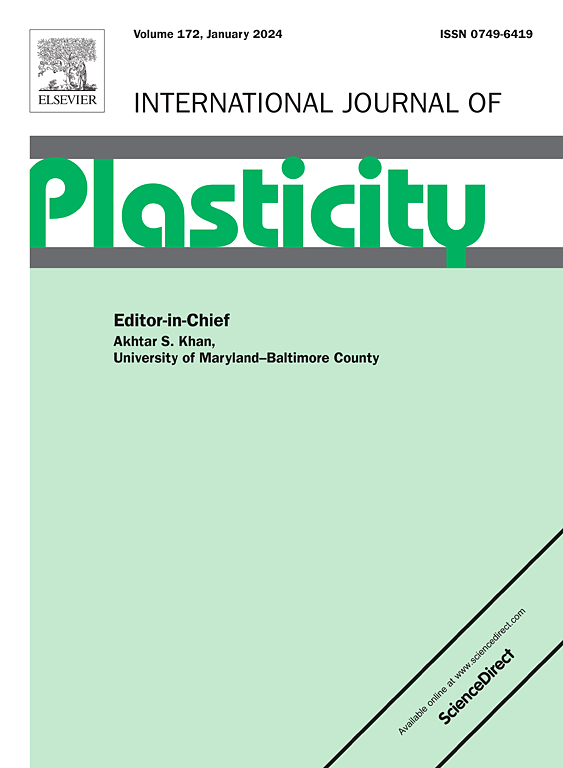Study of orientation-dependent residual strains during tensile and cyclic deformation of an austenitic stainless steel
IF 9.4
1区 材料科学
Q1 ENGINEERING, MECHANICAL
引用次数: 0
Abstract
This work presents a combined experimental and crystal plasticity finite element modeling study on the development of bulk and local residual strains during tensile and cyclic deformation of an austenitic stainless steel. The -specific bulk (residual) lattice strains are measured using X-ray Diffraction, while the local residual strains are measured using High Resolution Electron Back Scatter Diffraction. The residual strains are predicted using a dislocation density-based crystal plasticity model, with consideration for directional hardening due to backstress evolution. The work emphasizes on residual strain developments for four specific grain families: , , and , specifically in terms of their correlation with the underlying microstructure, studied using crystallographic orientation, misorientation, dislocation density and backstress evolution. Large intragranular orientation gradients, dislocation densities and backstress are observed during tensile deformation for the texturally dominant grain family, indicating that these grains have higher plastic deformation as compared to the and grain families. This also contributes to the observed relaxation in lattice strains for the grain family, with the resulting load shed being primarily accommodated by the grain family. In contrast, no such orientation gradients or lattice strain relaxations are observed in the cyclically deformed material. The measured local residual strains, which are also qualitatively predicted by the crystal plasticity simulations, highlight the additional effect of spatial heterogeneity and neighboring grains on the development of residual strains. Finally, statistical analysis of the simulated residual strains reveals that the hierarchy in the development of lattice strains is in the following order for the different grain families: for tensile deformation, and for cyclic deformation. The dominant factors contributing to the observed hierarchy are the elastic stiffness and the grain rotations (or lack thereof) for the different grain families during tensile and cyclic deformation.
奥氏体不锈钢拉伸和循环变形过程中取向相关残余应变的研究
本研究结合实验和晶体塑性有限元模型研究了奥氏体不锈钢在拉伸和循环变形过程中的体应变和局部残余应变的发展。(hkl)特异体(残余)晶格应变采用x射线衍射测量,局部残余应变采用高分辨率电子背散射衍射测量。利用基于位错密度的晶体塑性模型预测了残余应变,并考虑了背应力演化引起的定向硬化。本研究着重于(111)、(001)、(101)和(311)四个特定晶粒族的残余应变发展,特别是它们与底层微观结构的相关性,利用晶体取向、错取向、位错密度和背应力演化进行了研究。在拉伸变形过程中观察到较大的晶内取向梯度、位错密度和背应力,表明与(001)和(111)晶族相比,这些晶族具有更高的塑性变形。这也有助于观察到(101)晶粒族晶格应变的松弛,由此产生的载荷脱落主要由(001)晶粒族承担。相反,在循环变形材料中没有观察到这种取向梯度或晶格应变弛豫。实测的局部残余应变也通过晶体塑性模拟进行了定性预测,突出了空间异质性和邻近晶粒对残余应变发展的附加影响。最后,对模拟残余应变的统计分析表明,不同晶粒族的晶格应变发展顺序如下:拉伸变形(001)>(311)>(111)>(101),循环变形(001)>(311)>(111) ~(101)。在拉伸和循环变形过程中,不同晶粒族的弹性刚度和晶粒旋转(或缺乏旋转)是导致观察到的分层的主要因素。
本文章由计算机程序翻译,如有差异,请以英文原文为准。
求助全文
约1分钟内获得全文
求助全文
来源期刊

International Journal of Plasticity
工程技术-材料科学:综合
CiteScore
15.30
自引率
26.50%
发文量
256
审稿时长
46 days
期刊介绍:
International Journal of Plasticity aims to present original research encompassing all facets of plastic deformation, damage, and fracture behavior in both isotropic and anisotropic solids. This includes exploring the thermodynamics of plasticity and fracture, continuum theory, and macroscopic as well as microscopic phenomena.
Topics of interest span the plastic behavior of single crystals and polycrystalline metals, ceramics, rocks, soils, composites, nanocrystalline and microelectronics materials, shape memory alloys, ferroelectric ceramics, thin films, and polymers. Additionally, the journal covers plasticity aspects of failure and fracture mechanics. Contributions involving significant experimental, numerical, or theoretical advancements that enhance the understanding of the plastic behavior of solids are particularly valued. Papers addressing the modeling of finite nonlinear elastic deformation, bearing similarities to the modeling of plastic deformation, are also welcomed.
 求助内容:
求助内容: 应助结果提醒方式:
应助结果提醒方式:


